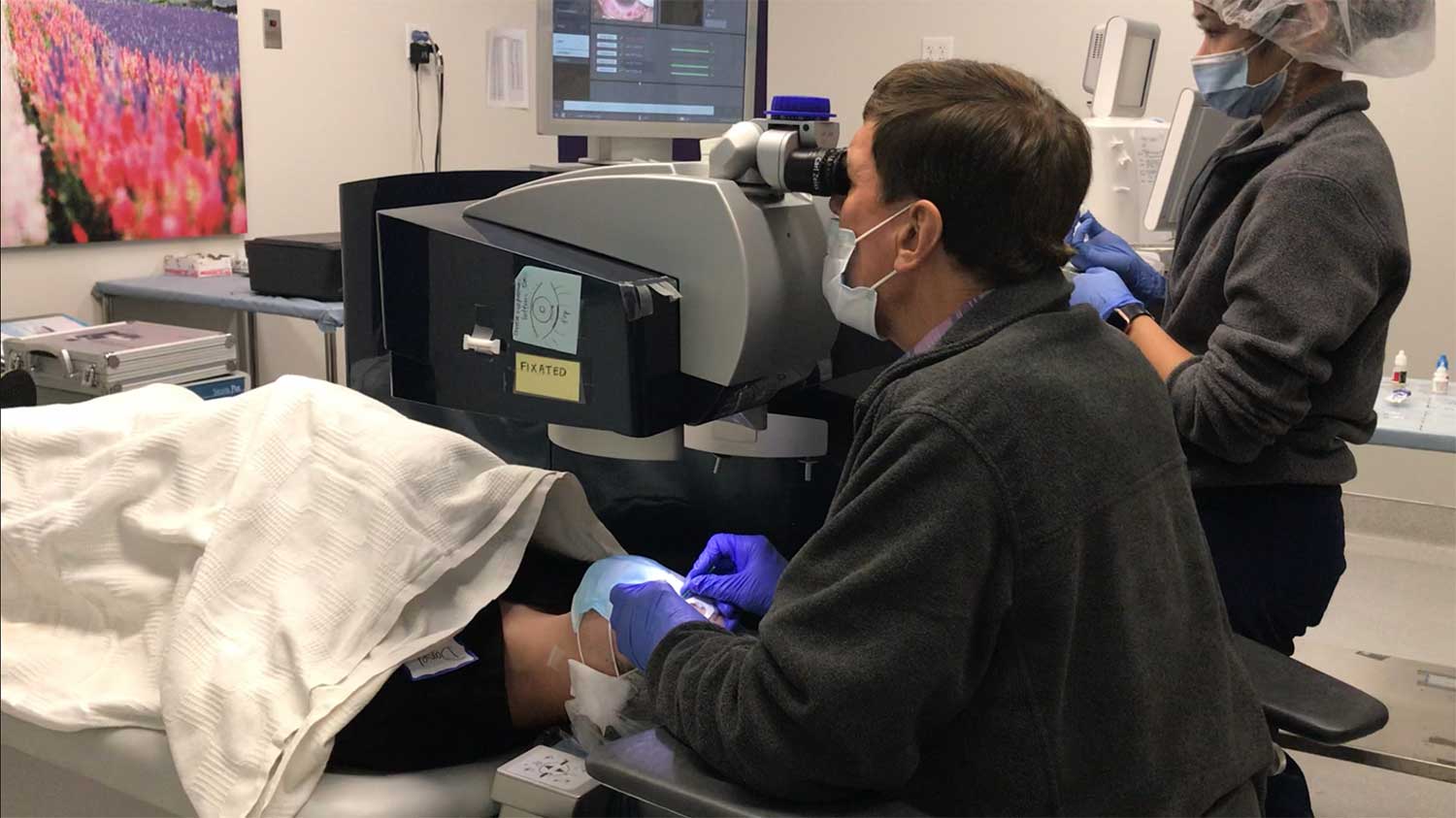Many people hesitate to make decisions that could significantly improve their lives because they’re unsure about what’s involved. This is especially true for those considering LASIK surgery to correct their vision. The idea of eye surgery might seem scary if you don’t know what to expect.
Our aim is to clear up any confusion and provide straightforward information about the entire LASIK process. We’ll cover everything from what happens during the surgery to what the recovery looks like. This way, you’ll have a better idea of what to expect and can feel more confident about making a decision that could change the way you see the world.
What Exactly is LASIK Eye Surgery?
LASIK eye surgery stands as a beacon of hope for millions seeking liberation from glasses and contact lenses. However, understanding what LASIK involves is the first step toward making an informed decision.
Down to its core, the procedure for LASIK eye surgery is solely designed to correct a wide range of vision impairments, including:
- Myopia (nearsightedness)
- Hyperopia (farsightedness)
- Astigmatism
The LASIK procedure uses a specialized laser where surgeons precisely reshape the structure of the cornea, the eye’s clear front. The procedure’s result improves the eye’s ability to focus light onto the retina, enhancing vision.
This one-of-a-kind medical procedure boasting high precision and effectiveness has evolved significantly since its inception. Currently, LASIK surgery involves cutting-edge technology and techniques that ensure higher accuracy, improved comfort, and quicker recovery times. From there, it became one of the most popular options for vision correction surgeries worldwide.
Common Concern #1: Procedure Duration and Comfort
When considering LASIK surgery, two of the most common questions revolve around the duration of the procedure and what kind of comfort or discomfort you can expect. Let’s break these down into simpler terms to help you understand what’s involved.
How long does the LASIK procedure take?
The LASIK procedure itself is surprisingly quick. In most cases, it takes several minutes to correct both eyes. This speed is thanks to advanced laser technology that is both precise and efficient. However, it’s important to note that while the surgery is short, you’ll need to allocate more time for the entire visit. This includes preparation before the surgery and a brief post-procedure care period at the clinic. So, while the laser work is quick, plan to be at the clinic for a few hours to ensure everything goes smoothly and safely.
Is LASIK painful? What kind of anesthesia is used?
One of the biggest worries about any surgical procedure is the potential for pain. The good news is that LASIK surgery is not considered painful. Before the surgery begins, numbing drops are applied to your eyes. These drops help ensure that you won’t feel any pain during the procedure. Most patients report feeling some pressure on their eyes as the laser works, but this is not painful. It’s a strange sensation, to be sure, but not one that causes discomfort. The use of numbing drops is a standard part of the LASIK process, making the experience as comfortable as possible for you.
How soon after LASIK surgery will I start to see improvements in my vision?
As the days progress, you’ll likely see continuous improvements in your vision. While some patients achieve near-perfect vision the day after surgery, it’s important to note that the healing process varies from person to person, and your vision may continue to stabilize and improve over the following weeks and even months. For a comprehensive understanding of what to expect post-surgery and to ensure your recovery aligns with typical outcomes, it’s advisable to maintain open communication with your eye surgeon and attend all scheduled follow-up appointments.
Common Concern #2: Safety and Efficacy of LASIK’s Laser Eye Surgery
When it comes to LASIK surgery, understanding the risks involved and the likelihood of success is crucial for anyone considering this vision correction procedure. Here, we’ll delve into the safety of LASIK and what you can realistically expect in terms of vision improvement post-surgery.
How Safe is LASIK Eye Surgery?
LASIK surgery is widely regarded as a safe option for correcting vision. Thanks to advancements in technology and surgical techniques, the procedure has a high success rate with minimal risks. Complications from LASIK are rare, and when they do occur, they are often minor and can be effectively treated.
It’s crucial, however, to have a detailed discussion with your surgeon about your specific situation. They can provide you with information tailored to your eye health, including any potential risks based on your unique eye structure and vision needs.
Success rates and potential for 20/20 vision
Many people opt for LASIK with the hope of achieving 20/20 vision, and a significant number of patients reach this goal. In fact, the majority of individuals who undergo LASIK surgery report significant improvements in their vision, with a large portion achieving 20/40 vision or better— the standard required for driving in most places without the need for glasses or contact lenses.
While not everyone will achieve perfect 20/20 vision as some patients are not fully correctable to 20/20 based on their eye health and anatomy, the success rates are high, and most patients are satisfied with their outcomes. The exact results can vary based on several factors, including the degree of vision correction needed and the patient’s overall eye health prior to the procedure.
What are the long-term effects of LASIK?
The surgery permanently reshapes the cornea, and its effects are lifelong, meaning the results do not wear off over time. However, as with any medical procedure, there are potential risks and side effects, although they are rare and often treatable.
Common long-term benefits of LASIK include correction of refractive errors such as nearsightedness, farsightedness, and astigmatism, leading to improved vision and freedom from glasses and contact lenses. It’s also important to note that LASIK does not prevent age-related vision changes, such as presbyopia, which may require reading glasses as patients get older.
Common Concern #3: Risks and Complications of LASIK Surgery
Just like any medical procedure, LASIK surgery comes with its own set of risks and potential complications. However, it’s worth noting that serious issues are rare, and the majority of patients go through LASIK without any significant problems.
Let’s break down what these risks are and how often they actually happen.
LASIK surgery is highly effective and safe, but, as with any procedure, there are potential risks. There can be minor issues like dry eyes and temporary visual disturbances such as glare and halos around lights.
The statistics are reassuring: more than 99% of LASIK patients do not experience severe complications. Common side effects such as dry eyes and difficulties with night vision usually improve on their own within a few months after surgery. For those few who do experience complications, most can be managed effectively with additional treatment or care. For example, dry eyes might be managed with eye drops or minor procedures to help retain eye moisture.
Understanding these risks and how they’re managed can help set realistic expectations and prepare you for a smooth LASIK experience. Remember, the best way to minimize your risk is to choose a reputable, experienced surgeon and follow all pre- and post-operative care instructions closely.
Common Concern #4: LASIK Post-operative Care and Recovery
After LASIK surgery, it’s normal to have lots of questions about what comes next. The recovery process is generally quick, but there are some key things you’ll need to know to make sure everything goes smoothly. Let’s dive into what you can expect after your procedure and how to ensure the best possible outcome.
What to expect immediately after LASIK surgery
Right after the surgery, it’s common to experience blurry vision. This is temporary and usually improves significantly within the first day. Think of it as looking through a not-so-clean window — your vision isn’t clear, but it’s not supposed to stay that way. To help with the healing process and prevent any complications, your doctor will provide you with several types of eye drops. These drops are designed to prevent infections, reduce inflammation, and keep your eyes from getting too dry.
Timeline for recovery and achieving optimal vision
Everyone heals at their own pace, but most people find that they can get back to their day-to-day activities the very next day after the surgery. However, it’s important to remember that your vision might take a bit longer to stabilize. Over the following weeks to months, you’ll likely notice gradual improvements in your vision. It’s a process, so give your eyes the time they need to fully recover.
Tips for a smooth and successful recovery process
Following your surgeon’s post-operative instructions is crucial for a smooth recovery. Here are a few general tips:
- Use your eye drops as directed: Keeping your eyes lubricated and free from infection is key.
- Wear eye protection if recommended: To avoid accidental rubbing or pressure on your eyes, you might be asked to wear protective eyewear, especially at night.
- Avoid rubbing your eyes: This can interfere with the healing process.
- Keep up with follow-up appointments: These appointments allow your surgeon to monitor your healing and catch any potential issues early on.
Common Concern #5: Costs of Laser Surgery for the Eyes
When it comes to understanding the costs associated with LASIK surgery, it’s important to recognize that prices can vary significantly based on several key factors. These include the technology used, the complexity of your vision correction needs, and the expertise of the surgeon performing the procedure. Each of these elements can influence the overall cost of your LASIK surgery.
Factors Influencing LASIK Prices
- Type of Laser Technology: The specific laser technology your surgeon opts to use can play a substantial role in determining the cost. More advanced laser systems may offer greater precision or faster recovery times, which can contribute to a higher price point. However, the benefits of these technologies, such as improved vision outcomes, often justify the extra cost.
- Extent of Vision Correction Needed: The complexity of your individual vision correction requirements also impacts the price. More complex cases, such as higher prescriptions or astigmatism, may demand more time and resources for successful correction, influencing the overall cost.
- Surgeon’s Expertise: The experience and reputation of the surgeon you choose are crucial factors that can affect the cost. Surgeons with extensive experience and a high success rate may charge more for their services, reflecting their expertise and the quality of care they provide.You can check the patients’ reviews on the LASIK eye surgeon‘s website to get an idea of their reputation.
- Post-operative Care and Follow-up Visits: It’s essential to understand what’s included in the quoted price for your LASIK surgery. Some providers may offer a comprehensive package that includes all necessary post-operative care and follow-up appointments, while others may charge additional fees for these services. Ensuring you have a detailed breakdown of costs before proceeding can help prevent unexpected expenses.
Insurance and financing options
Unfortunately, most insurance plans classify LASIK as a cosmetic procedure and do not cover it. However, some insurance companies might offer discounts off of the customary fees that can reduce the cost. Additionally, many LASIK providers offer financing plans or payment options to make the surgery more accessible. These plans can help spread the cost over time, making LASIK a more manageable investment for your vision health.
Investing in LASIK versus long-term costs of glasses and contacts
When looking at the cost of LASIK, consider it an investment in your vision. While the upfront cost might seem high, it’s helpful to compare it to the ongoing expenses associated with glasses or contact lenses. This includes the cost of frames, lenses, contact lens supplies, and routine eye exams over the years. For many, LASIK can be more cost-effective in the long run when considering the cumulative costs of alternative vision correction methods.
Schedule Your Lasik Eye Surgery with Saddleback Eye Center
Deciding to go for LASIK eye surgery is a big step towards achieving better vision and eliminating the need for glasses or contact lenses. If you’re considering this life-changing procedure, Saddleback Eye Center’s surgeon Dr. Manger, the best LASIK eye surgeon, is here to guide you through the process. Our team of experts use the latest technology and techniques to ensure the best outcomes for our patients. We understand that the idea of eye surgery can be daunting, but we’re committed to providing clear, straightforward information and compassionate care from start to finish. Schedule your consultation with us to discuss how LASIK can improve your vision and quality of life. Together, we’ll take the next step towards clearer vision.





 The Ad Firm
The Ad Firm